Table Of ContentAN
INTRODUCTION TO
HOMOLOGICAL
ALGEBRA
AN
INTRODUCTION TO
HOMOLOGICAL
ALGEBRA
BY
D.G.NORTHCOTT
PROFESSOR OF PURE MATHEMATICS IN THE
UNIVERSITY OF SHEFFIELD
fisfi
an;fluid
.. g .5
CAMBRIDGE
AT THE UNIVERSITY PRESS
1960
PUBLISHED BY
THE SYNDICS OF THE CAMBRIDGE UNIVERSITY PRESS
BentleyHouse,200EustonRoad,London,N.W.I
AmericanBranch:32East57thStreet,NewYork22,N.Y.
©
CAMBRIDGE UNIVERSITY PRESS
1960
Printed7?»GreatBritainatthe UniversityPress,Cambridge
(BrookeGrutchley, UniversityPrinter)
CONTENTS
Preface page 1x
1. Generalities concerning modules
1.1 Leftmodulesandrightmodules
w
1.2 Submodules w
1.3 Factormodules w
1.4 A-homomorphisms w
1.5 SomedifferenttypesofA-homomorphisms w
1.6 Inducedmappings m
1.7 Imagesandkernels a
q
1.8 Modulesgeneratedbysubsets
w
1.9 Directproductsanddirectsums
1.10 Abbreviatednotations —lM
1.11 SequencesofA-homomorphisms —‘DW
I
2. Tensor products and groups ofhomomorphisms
2.1 Thedefinition oftensorproducts 16
2.2 Tensorproducts overcommutativerings 17
2.3 Continuationofthegeneraldiscussion 18
2.4 Tensorproductsofhomomorphisms 19
2.5 TheprincipalpropertiesofHornA(B,0) 24
3. Categories and functors
3.1 Abstractmappings 30
3.2 Categories 31
3.3 Additive andA-categories 32
vi C0NTENTS
3.4 Equivalences page 32
3.5 Thecategories 911;and gfi 33
3.6 Functorsofasinglevariable 33
3.7 Functorsofseveralvariables 34
3.8 Naturaltransformationsoffunctors 35
3.9 Functorsofmodules 36
3.10 Exactfunctors 38
3.11 Leftexactandrightexactfunctors 40
3.12 Properties ofrightexactfunctors 41
3.13 A ®A0andHomA(B,0) asfunctors 44
4. Homology functors
4.1 Diagramsoveraring 46
4.2 Translations ofdiagrams 47
4.3 Images andkernels asfunctors 48
4.4 Homologyfunctors 52
4.5 Theconnectinghomomorphism 54
4.6 Complexes 59
4.7 Homotopictranslations 62
5. Projective and injective modules
5.1 Projectivemodules 63
5.2 Injective modules 67
5.3 Anexistencetheoremforinjectivemodules 71
5.4 Complexesoveramodule 75
5.5 Properties ofresolutionsofmodules 77
5.6 Propertiesofresolutionsofsequences 80
5.7 Furtherresults onresolutionsofsequences 84
CONTENTS vii
6. Derived functors
6.1 Functorsofcomplexes page 90
6.2 Functorsoftwocomplexes 94
6.3 Right~derivedfunctors 99
6.4 Left~derivedfunctors 109
6.5 Connectedsequencesoffunctors 113
7. Torsion and extension functors
7.1 Torsionfunctors 121
7.2 Basicpropertiesoftorsionfunctors 123
7.3 Extensionfunctors 128
7.4 Basicpropertiesofextensionfunctors 130
7.5 Thehomologicaldimensionofamodule 134
7.6 Globaldimension 138
7.7 Noetherianrings 144
7.8 CommutativeNoetherianrings 148
7.9 GlobaldimensionofNoetherianrings 149
8. Some useful identities
8.1 Bimodules 155
8.2 Generalprinciples 156
8.3 Theassociativelawfortensorproducts 160
8.4 Tensorproductsovercommutativerings 161
8.5 Mixedidentities 164
8.6 Ringsandmodulesoffractions 167
9. Commutative Noetherian rings offinite global dimension
9.1 Somespecialcases - 174
9.2 Reductionofthegeneralproblem 184
9.3 Modulesoverlocalrings 189
viii CONTENTS
9.4 Someauxiliaryresults page 202
9.5 Homological codimension 204
9.6 Modules offinitehomological dimension 205
10. Homology and eohomology theories ofgroups and
monoids
10.1 Generalremarks concerningmonoids andgroups 211
10.2 Moduleswithrespectto monoidsandgroups 214
10.3 Monoid—ringsandgroup-rings 215
10.4 ThefunctorsAGandAG 217
10.5 Axiomsforthehomologytheoryofmonoids 219
10.6 Axiomsforthe cohomologytheoryofmonoids 221
10.7 StandardresolutionsofZ 223
10.8 Thefirsthomologygroup 229
10.9 Thefirst eohomologygroup 230
10.10 Thesecond eohomologygroup 238
10.11 Homologyandeohomologyinspecialcases 244
10.12 Finitegroups 249
10.13 Thenorm ofahomomorphism 252
10.14 Propertiesofthe complete derivedsequence 256
10.15 CompletefreeresolutionsofZ 259
Notes 266
References 278
Index 281
PREFACE
The past ten years or so have seen the emergence ofa new mathe-
matical subject which now bears the name Homological Algebra.
To begin with, it was the concern of a few enthusiasts in certain
specializedfieldsbut, sincethepublicationofCartanandEilenberg’s
now famous bookj‘ its importance for several ofthe main branches
ofpuremathematicshasbeengenerallyrecognized.
The young mathematician, about to start on research, will be
anxious to learn about homological ideas and methods, and one of
theaimsofthisbookistohelphimtogetstarted. Intryingtocater
forhisneeds, Ihaveimaginedsuchareaderasbeingfamiliarwiththe
notions ofgroup, ring and field but still relatively inexperienced in
modern algebra. For him, the account given here is self—contained
saveinasmallnumberofparticularswhicharementionedbelow,and
whichneednotdiscouragehim.
An introduction to homological algebra must, ofnecessity, be an
introductiontothebookofCartanandEilenberg,forthestudentwho
wishes to go furtherwill need to read theirwork; but muchofgreat
interestandvaluehasbeenachievedevenmorerecently, andsomeof
thislaterworkhasbeengivenaplaceinthefollowingpages. Thelist
ofcontents gives afairly detailedpicture ofthe maintopics treated,
but afewadditionalcommentsmaybeahelp.
Chapters 1—6 develop, in a leisurely manner, the results that are
neededtoestablishandillustratethetheoryofderivedfunctors,after
whichfollowsanaccountoftorsionandextensionfunctors. Theseare
the most important ones which are obtainable by the process of
derivationand,inasense,theremainderofthebookisconcernedwith
theirapplications. Suchanapplicationisthetheoryofglobaldimen—
sion given at the end ofChapter 7, and here are included some im—
portant results of M. Auslander on Noetherian rings that have
previously beenavailableonlyintheoriginalresearchpaper.
Chapter9dealswiththestructureofcommutativeNoetherianrings
1' H. Cartan and S. Eilenberg, Homological Algebra (PrincetonUniversity Press,
1956}
x PREFACE
offinite global dimension and represents one ofthe most satisfying
achievements ofhomologieal methods. This, too, appears in a text-
bookforthefirsttime. Here, itmustbeadmitted, theaccountisnot
completely self-contained, but considerable care has been taken in
explainingtheresultsofIdealTheorywhichareneededtosupplement
thepurelyhomologicalarguments.Thisisthemostambitiouschapter,
and the author hopes that it will help to stimulate interest in com-
mutativealgebra. Thetreatmentgivenherewasfoundsuccessfulina
courseoflecturesinwhichtheaudiencehadnospecializedknowledge
ofclassical Ideal Theory.
Chapter 10 is an introduction to the homology and cohomology
theories of monoids and groups. This, by itself, has a considerable
literature and was one ofthe earliest branches of our subject to be
developed. The chaptercan beread, ifdesired, before Chapter 9 and
does not require any specialized knowledge of Group Theory.'[' In
decidinghowfartogowiththistopic, Ihadinmindthestudentwho
mightwishto acquiresomegeneralbackgroundbeforeproceedingto
theapplications in somespecializedfieldsuchasClass Field Theory.
Nearly all the topics coveredin the following pages wereincluded
in a course oflectures given at Sheffield University. Whenlecturing,
itispossibleto digressat somelengthin ordertoexplainthegeneral
plan of development and the connexions with other branches of
mathematics. Also onelikes to mention important results connected
withwhatoneisdiscussingevenifthereisnotimeforafulltreatment.
Some ofthis supplementary material, which I hope will add to the
enjoyment and interest ofthe main text, will be found in the Notes
which follow Chapter 10.
Thefinal chapterhas been muchimproved as theresult ofsugges-
tions ofJ. Tatewith whom I hadanopportunityofdiscussingit. At
Sheffield, I have been aided, at all stages, by my colleague H. K.
Farahat. Ofparticularvaluehasbeenhiswillingnesstodiscusspoints
ofdetail and to makehelpfulcriticisms. Thisworkowesa great deal
to his continued interest. Iam also indebted to Sir William Hodge,
who, when I first had the idea ofwriting an introduction to homo-
logicalmethods, encouragedmetogo ahead.
1‘ Thereisactually onereferencetoaresultprovedin Chapter 9, butthere isno
difficultyintakingthisoutofcontext.

